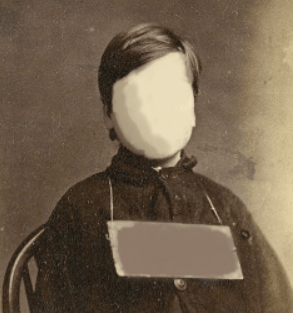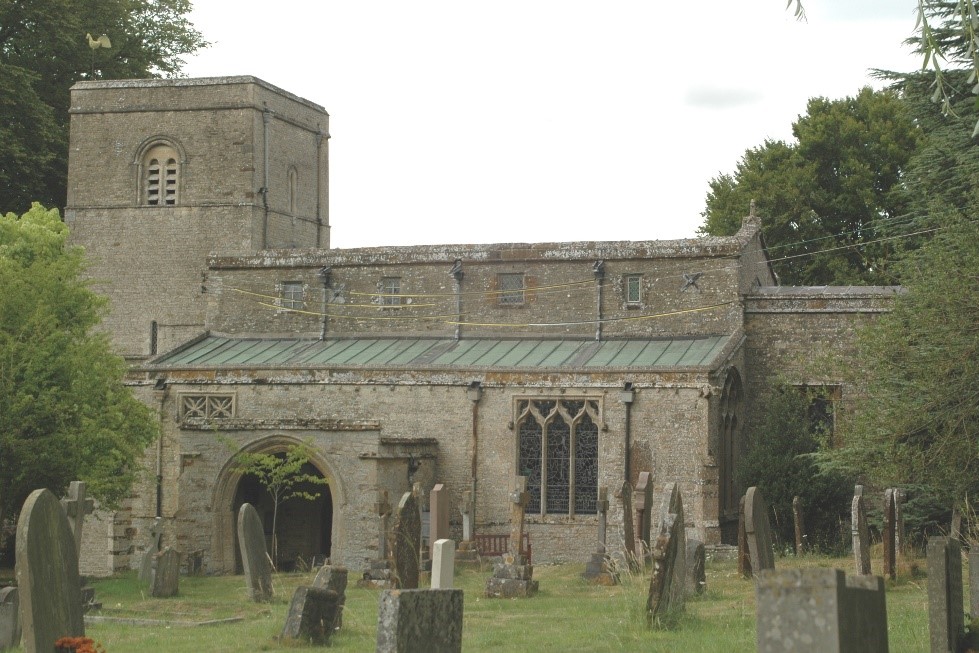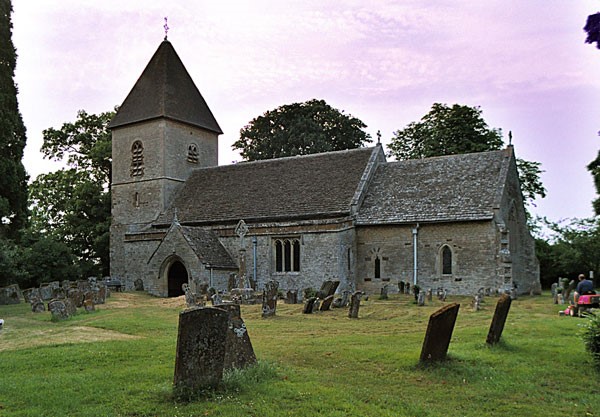
Summary
Edward Smith was no common thief, though common he may have been. Bearing none of the tattoos that marked a gang member, nor having a criminal history as long as your arm, one can imagine him toiling in a field from daybreak to night’s end: his eye on the soil and not on his master’s property. However, one event would shape his life and turn his previously earnest living into one of disrepute.
That’s not to say he did not commit any number of petty thefts or small crimes, but for these we have no record or intimation that prior to the conviction, and the events surrounding it, that he lived anything but an honest and decent life.
Early Life
Edward Smith was likely born sometime in 1812 and was baptised on the 24th October that same year[1]. In the village of Souldern, the Smiths were as permanent a fixture as the bricks of the parish church, St Mary’s. Edward’s father William was an agricultural labourer, a ubiquitous profession for the rural classes, and a calling which Edward, for want of education and opportunity, was compelled to follow. For a number of years, the seasons would have dictated his life, sowing in spring, harvesting in summer, ploughing in autumn and surviving in the winter. Backbreaking labour before the invention and, indeed, intervention of the industrial revolution; a technological advance which would see great upheaval in rural communities.

Edward’s three times great-grandchild tells the story of the Swing Riots, successors to the machine breaking luddites, who throughout the south of England demanded that landowners either remove their machines or up the workers wages; those who did not accede saw the destruction of their property. In the Oxford Journal, printed the 5th March 1831, there is a record of the Oxford Assizes where “Edward Smith, John West, and William Smith were indicted for burning and destroying a thrashing machine, the property of John Barnard, of Steeple Barton, on the 25th November last”[2].
Was this our Edward? Steeple Barton is not far from Souldern and Edward, as an agricultural labourer, would have been much opposed to machinery and would have only gained from their destruction. There are however serious discrepancies in age, Edward would’ve been 17 and not the 21 purported in the article and there is a lack of information to pin it precisely to him; a number of Smiths were born within the locale. Lastly his prison record, for a later crime of sheep stealing, must record previous crimes and yet makes no mention of this.
Here, life takes a turn for Edward when he meets and marries Caroline Fawkes, scion of a dynasty of fairground entertainers; she was a great-grand-daughter of Isaac Fawkes, a famous fairground magician in the 1700s. They were married on the 14th November 1839 at Fritwell parish church in a Church of England ceremony: the banns were read and the marriage sealed[3]. Five years previously, his brother Richard had married her sister Hannah Fawkes also in Fritwell, both Edward and Caroline had witnessed this ceremony[4] and perhaps this is where they first met and fell in love.

The same year that they married a son, Edward, was born. A further son, John, followed 2 years later before we see the family again in the 1841 census[5]. They lived in Souldern, the town of Edward’s birth. He is 25, she is 20, the eponymous son is 2 and little John a mere 6 months old. Over the proceeding years another flurry of children follows; Ann in 1843, Oliver in 1845, Clara in 1846, Emily in 1848, and Richard in 1850. If joy were measured in fecundity, they would be the happiest parents in all of Oxfordshire. In 1851, we see the now greatly enlarged family living at Bowling Leys, a poor lane, in Souldern[6]. The houses built in 1826, partly by the parish and partly by the parishioners themselves, had a small garden, perfect for growing children and vegetables[7]. A further 2 years later and young Gillery Smith was born.
Edward would’ve felt on top of the world and justly so, but if ever you’ve stood on top of a globe, you know that they can and will sometimes spin.
In May 1855, Caroline Smith died. On the 10th of that month, her cold unfeeling body was laid into the hallowed, hollow ground of St Mary’s church, Souldern: in the same church Edward was baptised, he buried his wife[8].
7 months later, his life would change once more.
The Crime
“Henry Bird and Edward Smith, of Souldern, were charged by Isaac Berridge, of Somerton, with having stolen, on the 23rd of December instant, a ewe sheep, his property. Remanded till Friday next. The same men were also remanded on a charge of stealing a ram teg, on the 10th inst. the property of Mrs. Hyde, of Fritwell.”[9]
On the 28th December 1855, Edward Smith and Henry Bird were committed to Bicester gaol. One can only imagine what hardship led Edward to such an act, with 8 hungry mouths to feed and the need to go out labouring each day, it must’ve been an impossible decision to make: to steal or starve. A number of newspapers at the time reported on the case but none with more than four lines to state the salient facts.
The defence, if any was given, is omitted from the historical record and even if Edward had plead his case, citing extenuating circumstances and bereavement, it did not work. Typically, a first-time offender would be given a nominal sentence or fine for a first crime, as Edward had committed two in quick succession, and both found out at the same time, he was judged as though he were a habitual criminal. Convicted at the Oxfordshire Epiphany Sessions on the 31st December 1855, the sentence passed was 4 years penal servitude.
Imprisonment
Edward was taken away and his details noted down. A fresh-faced complexion, brown hair, grey eyes, 5’6 ½ tall and of stout body. No scars, no tattoos, a protestant with no previous convictions. At aged 41 he was now alone in the world, his 8 children on the outside cared for by his brother Richard, listed as his next of kin. On the 1st January 1856 Edward received his first prisoner number, 2079, on entry to Millbank Prison[10].
Those first few months would have been incredibly hard, in solitude in the separate system and allowed only one hour’s recreation a day, the other 23 being spent in quiet contemplation and futile task. Still, his behaviour was good in Millbank and if he ever saw Henry Bird, who also was sent to Millbank[11], we know not what words were passed, if any, behind the masks required by the separation system.
From Millbank to Pentonville on the 15th February 1856[12]. Prisoner 6426, formerly a man, continued to toil and while away each day in industry. He would’ve been expected to pick coir, to turn a crank or do shot drills, work he certainly would’ve been capable of doing, but for one accustomed to making things grow by his hands, hard by seeing no fruits in the expenditure of his sweat. Henry Bird followed as far as Chatham, where on the 27th April 1857, prisoner number 875 arrived alone[13]. He was good[14], as at Millbank and Pentonville, and two years of his sentence had now passed with only two left to go. More toil, more industry till finally on the 6th May 1859 he was hand selected to build the new prison at Woking. His skill at tools, at toil, his good behaviour and the nature of his offence, neither violent nor gross, singled him out as a man who would be useful.
Prisoner number 46 built the prison which would later house those who, perhaps like himself, had fallen on hard times. The structure rose and rose till it was complete, save for the complement of inmates who would latterly fill it, and Edward was set free. On the 6th May 1859[15], Edward left the prison a number no more, but a man once again. This is the last reliable written record we have of him.
Aftermath
Neither Edward nor his brother Richard, appear again in a census but we can infer a great deal from their absence; an absence, highly suggestive of their having died before it. In 1861 at Market End workhouse in Bicester, his sons Richard and Gillery wiled away time[16]. At an Alms House in Deddington, 15-year-old Clara Smith served as a servant[17] and in Aynhoe, Ann Dunn formerly Smith, lived as an agricultural labourer’s wife.
From this point, Edward treads quickly into obscurity; the only proof of his ever having lived are a few scant censuses, a handful of prisons records and some newspaper clippings.
Special Thanks
Special thanks to Nick White, 3x great-grandson of Edward Smith, for all his help in this research
[1] ‘Oxfordshire, England, Church Of England Births And Baptisms, 1813-1915’ (Ancestry.com, 2020)
[2] ‘Swing Rioters’ (Swingriotsriotersblacksheepsearch.com, 2020) <http://www.swingriotsriotersblacksheepsearch.com/index.php?p=1_22_Oxfordshire> accessed 19 May 2018.
[3] ‘Oxfordshire, England, Church Of England Marriages And Banns, 1754-1930’ (Ancestry.com, 2020) <https://www.ancestry.com/interactive/61058/PAR110_1_R3_2_014?pid=386486&backurl=https://search.ancestry.com/cgi-bin/sse.dll?dbid%3D61058%26h%3D386486%26indiv%3Dtry%26o_vc%3DRecord:OtherRecord%26rhSource%3D8860&treeid=&personid=&hintid=&usePUB=true&usePUBJs=true&_ga=2.53553582.722641358.1588446098-380786153.1585521612> accessed 19 May 2020.
[4] ‘Oxfordshire, England, Church Of England Marriages And Banns, 1754-1930’ (Ancestry.com, 2020) <https://search.ancestry.com/cgi-bin/sse.dll?dbid=61058&h=386550&indiv=try&o_vc=Record:OtherRecord&rhSource=88602> accessed 19 May 2020.
[5] ‘1841 Census’ (www.ancestry.com, 2020) <https://search.ancestry.com/cgi-bin/sse.dll?indiv=1&dbid=8978&h=9426442&tid=&pid=&usePUB=true#?_phcmd=u(‘https://www.ancestry.com/search/?name%3Dedward_smith%26event%3D_souldern-oxfordshire-england-united%2Bkingdom_86860%26birth%3D1814%26count%3D50%26location%3D3257.3250%26name_x%3Ds_1%26priority%3Denglish%26successSource%3DSearch%26queryId%3Df435853b0fad9a7bb7323fc1c766219d’,’successSource’)> accessed 19 May 2020.
[6] ‘1851 Census’ (Ancestry.com, 2020) <https://www.ancestry.com/interactive/8860/OXFHO107_1729_1729-0432?pid=4138925&backurl=https://search.ancestry.com/cgi-bin/sse.dll?indiv%3D1%26dbid%3D8860%26h%3D4138925%26tid%3D%26pid%3D%26usePUB%3Dtrue&treeid=&personid=&hintid=&usePUB=true&usePUBJs=true&_ga=2.190924458.1847557757.1587661450-380786153.1585521612> accessed 19 May 2020.
[7] ‘1882 Notes Chapter VI’ (Souldern Village, 2020) <https://www.souldern.org/history/notes-on-souldern-1882/1882-notes-chapter-vi.html> accessed 19 May 2020.
[8] ‘Oxfordshire, England, Church Of England Deaths And Burials, 1813-1965’ (Ancestry.com, 2020) <https://www.ancestry.com/interactive/61059/BOD244_B_6_008?pid=706390&backurl=https://search.ancestry.com/cgi-bin/sse.dll?indiv%3D1%26dbid%3D61059%26h%3D706390%26tid%3D%26pid%3D%26usePUB%3Dtrue%26_phsrc%3DYkW335%26_phstart%3DsuccessSource&treeid=&personid=&hintid=&usePUB=true&_phsrc=YkW335&_phstart=successSource&usePUBJs=true&_ga=2.66127528.722641358.1588446098-380786153.1585521612> accessed 19 May 2020.
[9] ‘Bicester Advertiser’ (Britishnewspaperarchive.co.uk, 2020) <https://www.britishnewspaperarchive.co.uk/viewer/bl/0002108/18551229/012/0001> accessed 19 May 2020.
[10] ‘Millbank Prison Register’ (findmypast.co.uk, 2020) <https://search.findmypast.co.uk/record?id=TNA%2FCCC%2FHO24%2F007%2F00045&parentid=TNA%2FCCC%2F2D%2FHO24%2F00043246> accessed 19 May 2020.
[11] Ibid.
[12] ‘Pentonville Prison Register’ (findmypast.co.uk, 2020) <https://search.findmypast.co.uk/record?id=TNA%2FCCC%2FHO24%2F017%2F00052&parentid=TNA%2FCCC%2F2D%2FHO24%2F00087271> accessed 19 May 2020.
[13] ‘Chatham Prison Register’ (findmypast.co.uk, 2020) <https://search.findmypast.co.uk/record/browse?id=tna%2fccc%2fho8%2f140%2f045> accessed 19 May 2020.
[14] Ibid.
[15] ‘1861 Census’ (www.ancestry.com, 2020) <https://www.ancestry.com/interactive/8767/OXFRG9_896_900-0903?pid=18275187&backurl=https://search.ancestry.com/cgi-bin/sse.dll?indiv%3D1%26dbid%3D8767%26h%3D18275187%26tid%3D%26pid%3D%26usePUB%3Dtrue%26_phsrc%3DYkW340%26_phstart%3DsuccessSource&treeid=&personid=&hintid=&usePUB=true&_phsrc=YkW340&_phstart=successSource&usePUBJs=true&_ga=2.262619274.722641358.1588446098-380786153.1585521612)> accessed 19 May 2020.
[16] ‘1861 Census’ (https://www.ancestry.com/interactive/8767/OXFRG9_901_904-0205?pid=18278931&backurl=https://search.ancestry.com/cgi-bin/sse.dll?indiv%3D1%26dbid%3D8767%26h%3D18278931%26tid%3D%26pid%3D%26usePUB%3Dtrue%26_phsrc%3DYkW344%26_phstart%3DsuccessSource&treeid=&personid=&hintid=&usePUB=true&_phsrc=YkW344&_phstart=successSource&usePUBJs=true&_ga=2.92169628.722641358.1588446098-380786153.1585521612)> accessed 19 May 2020.
[17] ‘1861 Census’ (https://www.ancestry.com/interactive/8767/NTHRG9_921_925-0018?pid=18304289&backurl=https://search.ancestry.com/cgi-bin/sse.dll?dbid%3D8767%26h%3D18304289%26indiv%3Dtry%26o_vc%3DRecord:OtherRecord%26rhSource%3D8860&treeid=&personid=&hintid=&usePUB=true&usePUBJs=true&_ga=2.92275355.722641358.1588446098-380786153.1585521612)> accessed 19 May 2020.